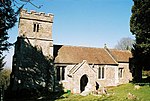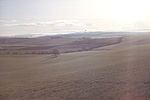Bulbarrow Hill

Bulbarrow Hill is a 274 metres (899 ft) hill near Woolland, five miles west of Blandford Forum and ten miles (16 km) north of Dorchester in Dorset, England. The chalk hill is part of the scarp of Dorset Downs, which form the western end of the Southern England Chalk Formation. Part of the hill is used for arable agriculture, but most is calcareous grassland. The hill overlooks the Blackmore Vale, and offers views of Dorset, Somerset, Wiltshire and Devon. Rawlsbury Camp, a five acre Iron Age hill fort, is situated on a promontory of the hill. Little remains of the camp except the twin embankments and intermediate ditch which surrounded it. The hill gets its name from the several barrows that adorn the hill. Additionally, a medieval trackway crosses the ridge. The hill is a popular launch site for paragliders. The TV presenter Jack Hargreaves who died in 1994 had his ashes spread on Bulbarrow Hill above his home, Raven Cottage.
Excerpt from the Wikipedia article Bulbarrow Hill (License: CC BY-SA 3.0, Authors, Images).Bulbarrow Hill
Geographical coordinates (GPS) Address Nearby Places Show on map
Geographical coordinates (GPS)
| Latitude | Longitude |
|---|---|
| N 50.85034 ° | E -2.33235 ° |
Address
DT11 0HE
England, United Kingdom
Open on Google Maps










